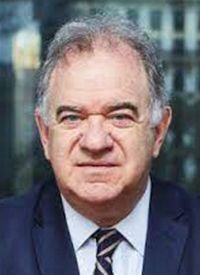Article
Remestemcel-L BLA Resubmitted to FDA for Pediatric Steroid-Refractory aGVHD
Author(s):
A biologics license application seeking the approval of remestemcel-L has been resubmitted to the FDA for the treatment of pediatric patients with steroid-refractory, acute graft-vs-host-disease.
Silviu Itescu, MBBS, FRACP, FACP

A biologics license application (BLA) seeking the approval of remestemcel-L (Ryoncil) has been resubmitted to the FDA for the treatment of pediatric patients with steroid-refractory, acute graft-vs-host-disease (aGVHD).1
The FDA will have up to 6 months to review the resubmission of the BLA upon its acceptance.
“There is an urgent need for a therapy that improves the dismal survival outcome in children with steroid-refractory aGVHD” Silviu Itescu, MBBS, FRACP, FACP, chief executive of Mesoblast, said in a press release. “Our team has worked tirelessly over the past two years to provide a comprehensive response to the FDA. We are grateful for the agency’s active dialogue and constructive feedback that will ensure a high bar is met in terms of product consistency and predictability of clinical outcomes.”
Remestemcel-L is an intravenously administered investigational therapy that contains culture expanded mesenchymal stromal cells taken from the bone marrow of an unrelated donor. The drug is thought to have immunomodulatory properties to counteract the inflammatory processes that are involved in steroid-refractory aGVHD by down-regulating the production of pro-inflammatory cytokines, increasing production of anti-inflammatory cytokines, and enabling recruitment of naturally occurring anti-inflammatory cells to involved tissues.
In April 2020, the FDA granted priority review designation to the initial BLA for remestemcel-L for the treatment of this population based on pooled data from 3 separate trials of 309 children with steroid-refractory aGVHD.2
In August 2020, the FDA’s Oncologic Drugs Advisory Committee voted 8 to 2 in favor of approving remestemcel-L in this setting after discussing whether data from the single-arm MSB-GVHD001 trial (NCT02336230) was sufficient to establish the efficacy of the drug.3
However, in October 2020, the FDA issued a complete response letter (CRL) to Mesoblast Limited,requesting additional data from at least 1 randomized, controlled study in adult and/or pediatric patients with steroid-refractory aGVHD.4
In October 2022, the company announced that it had submitted new information to the FDA regarding the items identified in the CRL.5 Following further guidance from the FDA, the company has provided additional data to support the efficacy of the agent in steroid-refractory aGVHD.
The BLA resubmission now includes additional clinical and biomarker data, including findings from a propensity-matched study of pediatric patients with high-risk disease, based on the validated MAP biomarker score, comparing outcomes in 25 children from the company’s phase 3 trial and 27 control children treated with various biologics, including ruxolitinib (Jakafi), from the Mount Sinai Acute GvHD International Consortium (MAGIC) database.
Results from the study showed that 67% of high-risk children treated with remestemcel-L responded to treatment within 28 days and were alive after 180 days, compared with 10% of patients in both categories in the MAGIC group.
The revised BLA also includes findings from a 4-year survival study performed by the Center for International Blood and Marrow Transplant Research in 51 evaluable patients with steroid-refractory aGVHD who were enrolled in the phase 3 trial. The results demonstrated durable responses, with a 1-year survival rate of 63% and a 2-year survival rate of 51% in a group of children with predominantly grade C/D disease (89%).
If approved, remestemcel-L would represent the first allogeneic off-the-shelf cellular therapy available for commercial use in the United States and the first treatment for pediatric patients under the age of 12 years with steroid-refractory aGVHD.
References
- Mesoblast resubmits biologic license application (BLA) to FDA for remestemcel-l in children with steroid-refractory acute graft versus host disease (SR-aGVHD). News release. Mesoblast Limited. January 31, 2023. Accessed February 1, 2023. https://investorsmedia.mesoblast.com/static-files/60aa26a8-85ce-4735-8fa6-2b0769eb6120
- FDA accepts Mesoblasts biologics license application for Ryoncil and agrees to priority review. News release. Mesoblast Limited. April 1, 2020. Accessed February 1, 2023. https://www.globenewswire.com/en/news-release/2020/04/01/2009842/0/en/FDA-ACCEPTS-MESOBLAST-S-BIOLOGICS-LICENCE-APPLICATION-FOR-RYONCIL-AND-AGREES-TO-PRIORITY-REVIEW.html
- Baird K. FDA session on clinical evidence: BLA 125706: Remestemcel-L. August 13, 2020. Accessed February 1, 2023. https://www.fda.gov/media/141131/download
- Mesoblast receives complete response letter from the FDA for biologics license application for steroid-refractory acute graft versus host disease in children. News release. Mesoblast Limited. October 2, 2020. Accessed February 1, 2023. https://investorsmedia.mesoblast.com/static-files/1e259fcb-77ba-470c-91af-1c71e5fa32e0
- Mesoblast submits new information to FDA IND file in response to items in the CRL to the remestemcel-L BLA for SR-aGVHD. News release. Mesoblast Limited. October 2, 2022. Accessed February 1, 2023. https://www.globenewswire.com/news-release/2022/10/02/2526431/0/en/Mesoblast-Submits-New-Information-to-FDA-IND-File-in-Response-to-Items-in-the-CRL-to-the-Remestemcel-L-BLA-for-SR-aGVHD.html









